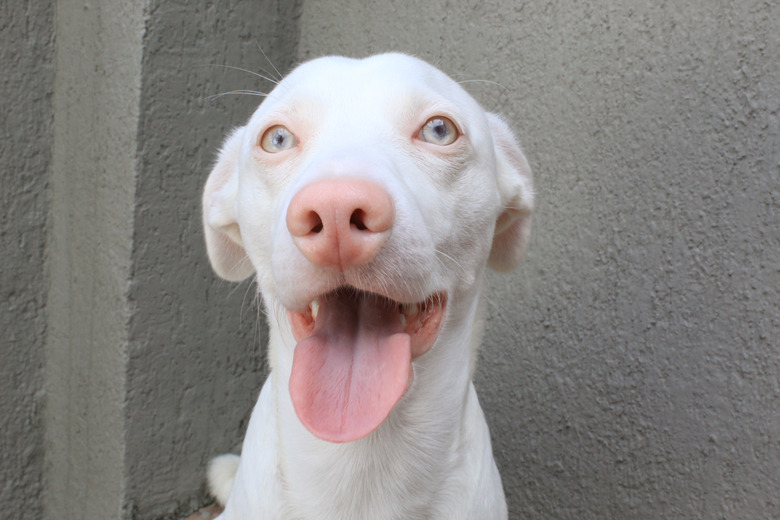Why Does My Female Dog Smell Bad?
Certain aromas make your home more inviting. Realtors advise sellers to bake apple pies or use scents such as vanilla, pine, or cedar to engage potential buyers. Not surprisingly, stinky dog is not on the list of enticing odors. Sometimes, a good bath eliminates smelly dog odor, but the cause is often more serious.
Many of the most common health conditions that produce foul odors, such as bad breath, urinary tract infections, ear infections, skin infections, impacted anal glands, or anal sac abscesses, relate to both genders. Certain breeds, such as Shar-Peis and English bulldogs, are more prone to skin infections and foul odors than others. But if your female dog smells, there's a chance her reproductive organs are to blame. If she's spayed, that's unlikely, but intact female dogs are prone to various health conditions, including infections. Take any dog with an unusual foul odor to the veterinarian for proper diagnosis and treatment.
Urinary tract infections in female dogs
Urinary tract infections in female dogs
While male dogs and female dogs may suffer from urinary tract infections (UTIs), such ailments are far more common in the latter than the former. Urinary tract infections, the most common cause of cystitis, have a variety of symptoms, and the female dog may experience secretions with a fishy smell coming from her vulva. Other signs of urinary tract infections include frequent urination, incontinence, licking the privates, and blood in the urine. The urine itself may smell particularly bad.
If your female dog exhibits any of these symptoms, or even if it's only foul-smelling urine, take her to the veterinarian for an examination. Some dogs don't show much in the way of clinical signs of a urinary tract infection, but without treatment, bacteria can sometimes ascend to the kidneys and cause infection, leading to kidney disease, scarring, and irreversible damage. The good news is that most urinary tract infections respond to antibiotics. If the UTI doesn't clear up, further diagnostic tests are in order.
Post-whelping infections in dogs
Post-whelping infections in dogs
If your dog has recently given birth, she's vulnerable to developing the bacterial infection known as metritis. While this infection generally starts within a week or so after whelping, it also occurs after a miscarriage or a less than sanitary artificial insemination. Metritis is more likely in dogs who went through a prolonged, difficult delivery or who may have retained a placenta or even a puppy. E. coli is the most common bacteria that causes metritis, and in a worst-case scenario, such an infection can lead to sepsis.
One of the primary symptoms of metritis is a foul-smelling vulvar discharge. Other symptoms include fever, less milk production, abdominal swelling, dehydration, appetite loss, and puppy neglect. Take your dog to the veterinarian along with the puppies. Along with testing the discharge for bacteria, the veterinarian will perform an X-ray or ultrasound to view the uterine interior.
Your dog will require hospitalization for at least a few days while she receives intravenous fluid therapy and other therapies. Based on lab results, your veterinarian will decide on the most appropriate type of antibiotic therapy; in most cases, spaying is the preferred treatment. While your dog recuperates, you must hand feed the puppies with a veterinarian-approved milk replacement so they are not exposed to the mother's bacterial infection or antibiotics via her milk.
Pyometra in dogs is a veterinary emergency
Pyometra in dogs is a veterinary emergency
If your dog is intact, she's vulnerable to pyometra, a potentially fatal uterine infection. Pyometra means "pus uterus" in Latin, and that graphic term pretty much describes what is happening to your pet. Pyometra most often occurs in dogs over age 5 and is most likely to happen one to two months after she has experienced a heat cycle.
Besides a horrible, fishy odor, signs of pyometra can include secretions that looks like pus exuding from the vagina, lack of energy, loss of appetite, vomiting, and increased thirst and urination, though with a closed pyometra, you may not see discharge. The dog is usually obviously unwell. Treatment is via emergency spay. If the uterus ruptures and pus enters the abdomen, the situation is more dangerous, and the prognosis is not good. Typically, these dogs rapidly go into shock and pass away.
Prevention is the best way to avoid pyometra. If you have no intention of breeding your dog, have her spayed when she is young. If she is a valuable breeding animal, spay her once she passes her prime reproductive years.
Impacted anal glands
Impacted anal glands
Another medical condition that can make a dog smell like something bad is when a dog's anal glands become impacted. Usually, a dog is able to secrete fluid from their anal glands normally, but sometimes that doesn't happen and they need help emptying them out. Symptoms of this condition may be excessive licking of the anal area or scooting across the ground. A groomer or a veterinarian can express the anal glands.
Ear infections and skin infections in dogs
Ear infections and skin infections in dogs
If you have a dog like a Shar Pei or some other breed that has a lot of skin folds, skin infections can develop within the folds. A dog's ear can also sometimes get infected, which can lead to a bad smell. It may sound odd, but if your dog smells like Fritos, that can mean an infection too. This smell, like corn chips, is the result of a yeast infection on a dog's paws.
The bottom line
The bottom line
Dogs are naturally a bit smelly, but if your female dog is emitting an unusually foul odor, it may indicate a serious health issue, such as an infection. In some cases, such ailments are life-threatening, so it is imperative to seek veterinary care immediately. If you do not intend to breed your female dog, consider having her spayed to reduce her risk of infections and other reproductive health problems.


